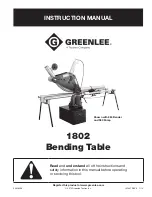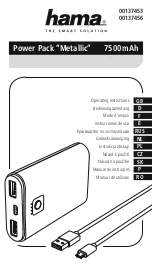
2
RISK OF EXPLOSION OR FIRE
What can happen:
• Spilled petrol and its vapours can become ignited from cigarette sparks, electrical arcing, exhaust
gases and hot engine components such as the muffler.
• Heat will expand fuel in the tank which could result in a fire.
• Operating the tool in an explosive environment could result in a fire.
• Muffler exhaust heat can damage painted surfaces, melt any materials sensitive to heat (such as
siding plastic, rubber or vinyl) and damage live plants. Keep hot tool away from other objects.
• Improperly stored fuel could lead to accidental ignition. Fuel improperly secured could get into the
hands of children or other unqualified persons.
How to prevent it:
• Shut off engine and allow it to cool before adding fuel to the tank.
• Use care when filling the tank to avoid spilling fuel. Move tool away from fuelling area before
starting engine.
• Keep maximum fuel level 20mm below top of tank to allow for expansion.
• Operate and refuel in well ventilated areas free from obstructions.
• Store fuel in a approved container (AS/NZS 2906-1999) for petrol. Store in a secure location away
from the work area. Make sure the container is clearly marked “fuel”.
RISK TO BREATHING
What can happen:
• Breathing exhaust fumes can cause serious injury or death.
How to prevent it:
• Operate tool in a well ventilated area. Avoid enclosed areas.
• Never operate unit in a location occupied by other people or animals.
SAVE THESE INSTRUCTIONS
1) Work area
a) Keep work area clean and well lit. Cluttered and dark areas invite accidents.
b) Do not operate petrol tools in explosive atmospheres, such as in the presence of flammable liquids,
gases, or dust.
Power tools create sparks which may ignite the dust or fumes.
c) Keep children and bystanders away while operating a petrol tool.
Distractions can cause you to lose control.
2) Personal safety
a) Stay alert, watch what you are doing and use common sense when operating a petrol tool.
Do
not use a power tool while you are tired or under the influence of drugs, alcohol, or medication. A
moment of inattention while operating power tools may result in serious personal injury.
b) Use safety equipment. Always wear eye protection.
Safety equipment such as a dust mask, non-skid
safety shoes, hard hat, or hearing protection used for appropriate conditions will reduce personal
injuries.
c) Remove any adjusting key or wrench before turning the tool on.
A wrench or a key that is left
attached to a rotating part of the petrol tool may result in personal injury.
d) Do not overreach. Keep proper footing and balance at all times.
This enables better control of the
petrol tool in unexpected situations.
e) Dress properly. Do not wear loose clothing or jewellery.
Keep your hair, clothing and gloves away
from moving parts. Loose clothes, jewellery or long hair can be caught in moving parts.
f) If devices are provided for the connection of dust extraction and collection facilities ensure that
these are connected and properly used.
Use of these devices can reduce dust-related hazards.
3) Petrol tool use and care
a) Do not force the petrol tool. Use the correct petrol tool for your application.
The correct petrol tool
will do the job better and safer at the rate for which it was designed.
SAFETY INSTRUCTIONS



































